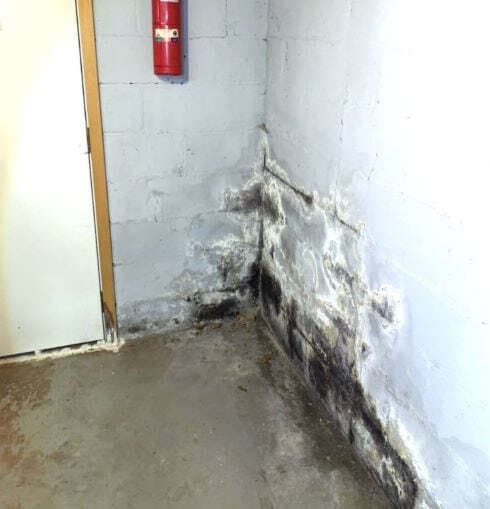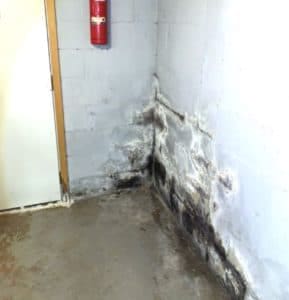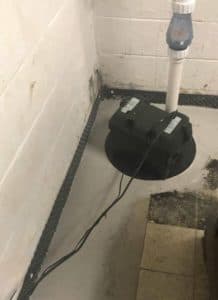
Have you noticed water seeping into your basement? Have you been sweeping it into the drain that’s set into the floor? If you’re doing this every time it rains, it’s time to talk to a professional about waterproofing.
You may be inclined to shrug off this advice; after all, it’s coming from a company that specializes in waterproofing. But that doesn’t change the fact that it is very good advice, and we want you to understand why.
Acculevel is a waterproofing company. Founded in 1996 by Andy Beery, we are family-owned and operated. We’ve installed water drainage systems for tens of thousands of customers, and we think every homeowner should have access to honest and direct information about waterproofing systems and products.
We’ve written this blog for that purpose: to help you understand why a floor drain is not a good substitute for professionally installed water drainage. We’ll explain what the original purpose of that drain is, explain how water drainage is different, and offer you some suggestions on how to proceed if you decide you want to “finish” part or all of your basement.
 This photo was taken by an Acculevel project manager on a free estimate appointment. Water has been seeping into the basement, allowing mold to grow in the corner.
This photo was taken by an Acculevel project manager on a free estimate appointment. Water has been seeping into the basement, allowing mold to grow in the corner.
Builders install a drain in a basement floor, largely in case of an emergency like:
Your HVAC installer may also route the condensate line to the floor drain, also. The floor drain can be connected to the sewer system or storm drains, just like any other drain in your home. Because of this connection, you may occasionally have foul odors coming from the drain. Worst of all, if a major plumbing issue occurs that drain can ‘back up’ or overflow into the basement from the sewer or storm drain.
You do not want to rely on a floor drain for regular water seepage into your basement.
If you have water seeping into your basement, you should have this evaluated by a professional contractor. This is especially true if the water intrusion is new or substantial. Water can cause significant issues in your foundation; cracks, bowing walls, and settling are all caused by water pressure in the soil around your foundation. The term for this water pressure is hydrostatic pressure, and we have an article that explores this topic for you in detail, here.
Once you’ve had any potential foundation issues resolved, then it’s time to address the water seepage.
 This photo was taken by an Acculevel crew member, after a waterproofing installation was completed. The drainage is installed into the perimeter of the floor, which directs water to the sump pump in the corner.
This photo was taken by an Acculevel crew member, after a waterproofing installation was completed. The drainage is installed into the perimeter of the floor, which directs water to the sump pump in the corner.
Waterproofing is done by installing a water drainage system. This system consists of two major components, a drainage channel and a sump pump. There are several different options for the drainage channel, which is installed around the perimeter of your basement. The best options are installed under the basement floor. These channels collect the water that gets in your basement, and direct it to the sump pump pit (the hole in the floor that houses the sump pump). This pump controls how the water drains: via a drainage line that goes through your basement wall to the outside of your property.
Your HVAC condensate line can be routed to the sump pump pit to be drained out of the basement. If you have a dehumidifier installed, the drainage line for that can also be directed to the sump pump pit. And in the event of an emergency like a leaking water heater, those flood waters can also be emptied out through the sump pump.
Unlike a floor drain, your water drainage system can operate on a daily or weekly basis without any difficulty. A sump pump pit does not connect in any way to your plumbing or sewer system, so it won’t ever be a source of backed-up effluent, either.
When a floor drain is installed in a basement, it’s done with the assumption that your basement is not going to be living space. Often the floor in your basement will also have a slight slope built into it, sloping towards the drain in the center.
If you decide that you’d like to change this- maybe to add a man cave, theater room, or home office- you’ll need to deal with that floor drain. No one ever wants sewage backed up into their basement, but you definitely don’t want it to happen after you’ve installed drywall, carpeting, and furniture!
We recommend that you have a quality plumber install a backwater valve in the floor drain. This will ensure that drain can only work in one direction (out!). This will prevent anything, including sewage, from flowing into the home. Once this is done, you can have the drain covered with concrete. If your floors are often sloped, this would also be a good time to have the floor leveled, too.
Ideally, you would then encapsulate the basement, to make sure your basement stays clean and dry. We have a blog that fully explores the benefits of encapsulation, and explains how it can work for you.
We’ve recently completed a comprehensive waterproofing guide, that explores everything from the reasons why a basement leaks to what it costs to install water drainage. You can read it from start to finish, or concentrate only on the chapter that interests you.
For visual learners, we have a video course that covers the same topic. Our own Greg Backus walks viewers through the process, starting here:
If you’re ready to get some quotes for waterproofing, we can help you with that, too! We’ve assembled a checklist of the questions you should ask a contractor, and included a free downloadable copy for you to use.
Of course, if you live in Indiana or the surrounding areas, you can contact us for a free estimate. One of our friendly and knowledgeable project managers will meet you at your home, review your basement, and provide a free written estimate that recommends the best course of action for you.
[DISPLAY_ULTIMATE_SOCIAL_ICONS]